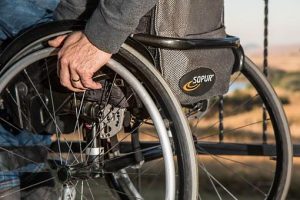There have been growing calls for greater attention to intersectionality in queer spaces and mobilizing. Yet, many queer disabled people still feel like they are being left behind and invisible within the queer movement. This is what I have found in my recent study focused on the romantic and sexual experiences of 31 queer people labeled/with developmental and intellectual disabilities in Alberta, Canada.
Disabled people, especially those labeled/with intellectual disabilities, are so commonly de-sexualized in their everyday lives that it is often believed that conversations about sex and sexuality are irrelevant to this social group. Not only that, but it is also the case that some non-disabled people assume that disabled people simply cannot identify as queer. Sometimes, talking about sexualities (in the plural) among disabled people, is seen as “going too far.” I have personally encountered service providers who referred to the intersection of disability and queerness as being “too much” or “too nuanced” to be addressed. Many struggle to find resources to support queer disabled people when they come out. The needs of queer people with disabilities are rarely considered in service provision and community supports. In fact, none of the participants had access to sexuality education in their schools and communities that addressed questions of sexual orientation in ways that would be relevant to disabled people.
By living at this intersection, queer disabled people often have to navigate both experiences of ableism and queerphobia. As one bisexual autistic participant shared, “Being on the spectrum, in my mind was already bad enough. If people knew I was bisexual, too, I feel like that make me just even more of an outcast. So, I just followed what everyone else did. And I tried to keep my head down low.” In addition, many must decide whether to “come out” as queer and/or disabled at different occasions. For those receiving direct care from family members and care workers, the fear of potentially losing those relationships and supports can discourage them from being open about their sexual identities. Some disabled people are even ridiculed, criticized, or punished for expressing their sexual desires. This might mean, for instance, increased surveillance from family members and direct care workers, which further prevents intimate relationship from being formed.
The current pandemic has had devastating impacts across various marginalized communities, including among queer people. From a lack of access to queer-friendly spaces and communities to access to (already few) supports and resources, the pandemic hit the community hard. The pandemic proved to be as harsh, if not harsher, for many disabled people in the community. Activists from People First of Canada, a national organization representing people labeled/with developmental and intellectual disabilities, pointed out how this social group was the “left behind of the left behind.” For some, the experiences with social distancing, for example, reminded of times living in institutions.
More and more disabled people now live in the community rather than in segregated care and it is important to ensure that people with disabilities can be active participants in the community. Yet, queer spaces, and even some Pride-related events, can be inaccessible to disabled people. It is worth mentioning that accessibility is more than merely building ramps at the back of the club. What participants have importantly pointed out is that accessibility is also about being meaningfully invited into queer spaces and offered spaces that are not overly sensory stimulating. For instance, for some queer disabled people, queer spaces, especially those involving loud music and other forms of sensory stimulation can be inaccessible: “I have to be like in a headspace where I can deal with the sensory stuff with it.” Instead, people shared their desire “sensory friendly place[s] where there’s like, good lighting, um not really too much noise. And you can just kind of hang out.”
Many participants also commented on the lack of representation of queer disabled people, which led some to feel like “outsiders” in their own communities. As one participant simply put, “I didn’t really want to participate in queer spaces because I felt like an interloper. I felt like I did not belong.” According to many participants, it is hard navigating queer spaces that do not consider disability and accessibility while they attempting to find disabled spaces that are thinking about questions of gender identity and sexualities. Not having a community that fully embraces both their queer and disabled existence, many participants feel stuck in the middle, feeling like an outsider in both communities.
In the face of these challenges, queer disabled activists and scholars are taking matters to their own hands and are using a variety of platforms, such as blogs, podcasts, and YouTube channels, to raise awareness about experiences at this often-disregarded intersection and challenge the invisibility of queer disabled people. Also, recent TV shows, like Special and the reboot of Queer as Folk too, are trying to increase the visibility of queer disabled people. In such way, queer disabled people are showing how disabled people are “also here and queer.”
Dr. Alan Martino is an Assistant Professor in Community Rehabilitation and Disability Studies at the University of Calgary in Canada. You can follow them on Twitter @AlanSMartino


Comments